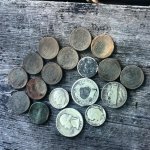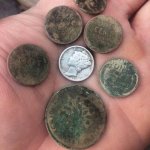calabash digger
Banned
- Joined
- May 3, 2016
- Messages
- 2,566
the deus was designed to hit SMALL tiny roman hammered coins you can set it up and dig bb s all day if that makes you happy. Ive been watching and
participating in the debate on detectors for awhile . I have got a question how many actually PERSONALLY have tested detectors side by side or are you just going on what your heard? As for testing detectors you can throw off on that if you want ,but if you lay a nail down and a coin beside it and your detector wont hit it do you think it will magically perform better in the field? I hear people throwing off on test gardens too ok they are not perfect but can give you a GOOD idea of a detectors performance capabilitys .I will say this about the deus it weighs 2 pounds think about swinging a detector that weighs half of what your swinging. Some people say deep when speaking of their detectors I can hit a 14 silver quarter in my soil and a 15 inch silver half with a nine inch coil in my soil thats deep. Ok a fancy id screen put some trash in that mix or iron and what do you have ? Ive not seen the v3i in action but have the ctx it changes a little with iron and trash in the mix. I can say this whatever you are comfortable with use . For relics I use a lighting fast deep seeking whipping stick it tells me dig or dont dig at a high rate of speed, the ctx you have to swing like granny and the v3 i I have no idea have the swing speed is but it weighs double the deus. So some days I dig upwartds of a 100 targets I just need to know quickly dig or dont. thats my style of hunting and thats WHY my machine fits me.
participating in the debate on detectors for awhile . I have got a question how many actually PERSONALLY have tested detectors side by side or are you just going on what your heard? As for testing detectors you can throw off on that if you want ,but if you lay a nail down and a coin beside it and your detector wont hit it do you think it will magically perform better in the field? I hear people throwing off on test gardens too ok they are not perfect but can give you a GOOD idea of a detectors performance capabilitys .I will say this about the deus it weighs 2 pounds think about swinging a detector that weighs half of what your swinging. Some people say deep when speaking of their detectors I can hit a 14 silver quarter in my soil and a 15 inch silver half with a nine inch coil in my soil thats deep. Ok a fancy id screen put some trash in that mix or iron and what do you have ? Ive not seen the v3i in action but have the ctx it changes a little with iron and trash in the mix. I can say this whatever you are comfortable with use . For relics I use a lighting fast deep seeking whipping stick it tells me dig or dont dig at a high rate of speed, the ctx you have to swing like granny and the v3 i I have no idea have the swing speed is but it weighs double the deus. So some days I dig upwartds of a 100 targets I just need to know quickly dig or dont. thats my style of hunting and thats WHY my machine fits me.








 Relics in my understanding include coins as well
Relics in my understanding include coins as well